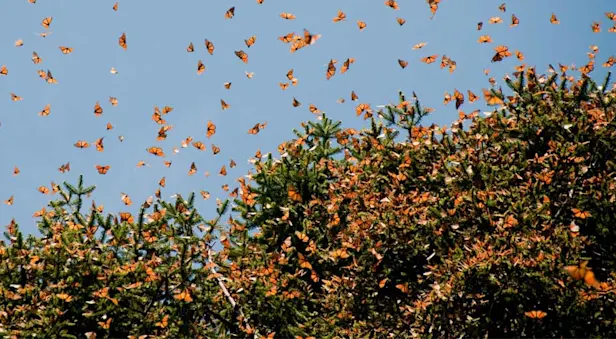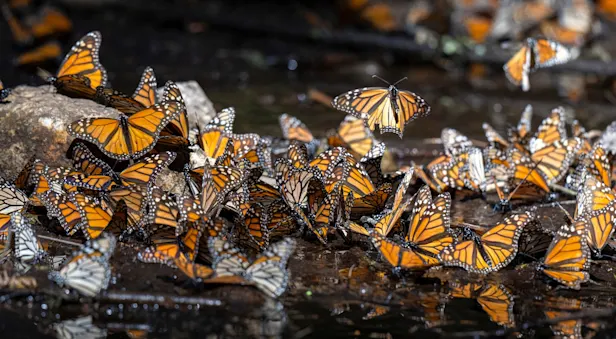
Know Before You Go


Monarch Butterfly Facts | Know Before You Go
Physical Characteristics
The monarch butterfly is the most commonly occurring species of milkweed butterfly, aptly named after the larvae that feed on the milkweed plant. The monarch, which primarily inhabits North America, is a medium-sized butterfly, measuring about 3 inches from wingtip to wingtip, with a 1-inch-long body. Its four wings are vivid hues of yellow, orange or gold strewn with veins of black; its body is black as well. Outlining the wings is a band of black, which is thickest at the front and speckled with white spots that grow smaller toward the back.
It is possible to distinguish sex between the male and female monarch. To do so, observe the vein pigmentation on the monarch’s wings, which is noticeably thicker on the female. In addition, the male has swollen pouches on its hind wings, whereas the female does not.
Sensory Systems
A butterfly’s sensory system is very different from that of a human; for example, unlike humans, it can hear ultrasound and view ultraviolet light. Due to these profound differences, it can be very difficult to effectively study the monarch’s sensory perception, as these senses may be used in many ways that are difficult for us to recognize. We do know, however, that a monarch uses its sensory systems of taste, smell, touch, sight and hearing to help it find a mate, to forage, evade predators and select a plant to lay its eggs.
A monarch’s senses of taste and smell are usually the most well developed. Amazingly, its taste sensors, located on the ends of its two large pairs of legs, are 2,000 times more sensitive to tasting sugars than those of a human. In addition, the red smelling sensors on each of its antenna tips are about 5,000 times more sensitive to smell than the human nose!
Monarchs sense touch via small hairs called tactile setae. These sensitive hairs protrude from sockets in their exoskeleton and are connected to nerve cells, which convey details on the tactile setae’s movement to the butterfly’s brain. An adult monarch’s tactile setae nearly encompass its entire body and help it sense the position of various body parts. Tactile setae are particularly important for flight because they help the butterfly sense gravity, wind and the position of its wings. Hairs on the antennae assist the monarch with olfaction in addition to touch. Tactile setae on a larva are relatively uniform over its entire body and are easily visible to the human eye through a magnifying glass.
Activity
The monarch butterfly is only active in the daytime, as it requires temperatures above 54°F for flight. On rainy or cold and cloudy days that do not meet these conditions, butterflies will generally remain grounded.
Reproduction
Although every aspect of the monarch butterfly’s life is interesting to observe, their mating rituals are one of the most fascinating. It is the male monarch that initiates the mating process, which occurs in the spring, just prior to migration from the overwintering sites.
Courtship is composed of two distinct stages: the aerial phase and the ground phase. During the breeding season, males roost in tree branches and at the tops of tall plants, bathing in sunshine. Each time a butterfly passes by, the male investigates whether it is of the right species and sex. When a female monarch is found, the male glides over to her and bumps into her abdomen. A courtship dance ensues, as the monarchs encircle high into the air.
A receptive female begins mating with the male in mid air. This display lasts several hours until they eventually drift to the ground where copulation takes place. The male’s sperm transfers into the female, along with a spermatophore—a protein capsule thought to provide energy to the female during reproduction and migration.
The fertilized eggs remain inside the female until she reaches her breeding grounds. The female monarch has six microscopic needles on each of her two forelegs. Upon arrival, the monarch, in search of a satisfactory milkweed to reproduce on, taps her needles into the plant, allowing the sap to seep out onto a leaf. She then tastes and smells the fluids to determine whether that particular plant is a suitable home for her eggs. She does this through the use of the taste sensors located on the bottom of her other four legs, in addition to the smell sensors on the ends of each of her antennae. When a suitable host plant is found, the monarch deposits her eggs on the bottom of a milkweed leaf, often one that is growing near the top of the plant. The eggs are laid one at a time, but amazingly there will be almost 400 eggs deposited before she is finished. Upon completing this egg-laying task, the female will die within a few days.
During the first three or four days, the egg starts to become dark in color, as the caterpillar eats its way out. The caterpillar feeds on milkweed for the next fifteen days at a relentless pace, increasing its weight 2,700 times. By day five, the larva must molt in order to continue its growth. The caterpillar sheds its skin three more times before preparing to pupate. On the fifteenth day, the larva’s skin starts to harden in preparation for metamorphosis.
Life Cycle
All insects complete a metamorphosis, changing their form as they develop. This process is triggered by hormones circulating within the insect’s body. Butterflies have four defined stages as they undergo a complete metamorphosis from egg, larva, pupa to adult.
Egg
The life of an individual butterfly begins with an egg, which is encased in a protective, outer shell called the chorion. A layer of wax lining the shell helps retain the egg’s moisture. Micropyles are funnel-shaped holes found at one end of the egg. These openings are crucial, as they allow the sperm to enter the egg, given that the egg develops its hard shell before it is fertilized. Ridges on the surface of the egg’s shell are formed in the female’s ovaries before eggs are laid.
Larvae
A larva’s head has short antennae, mandibles and twelve eyes known as ocelli. Despite its many eyes, a caterpillar’s vision is still very poor; however, it does have some assistance in this area. Its antennae assist with navigation, and sensory organs—called maxillary palps—help guide food into the caterpillar’s jaws. Each larva usually has five pairs of false legs known as “prolegs,” which contain tiny hooks that keep the larva attached to leaves. The caterpillar has fleshy, sensory tentacles at its front and back end. Similar to other insects, these larvae take in oxygen through spiracles, which are openings in their thorax’s sides. The spiracles are attached to the tracheae, and these air tubes channel oxygen through the body.
As larvae, monarchs eat the milkweed plant, which has the added effect of containing toxic compounds in the sap that are poisonous to birds who may prey upon them. The cardiac glycosides toxins accumulate in the larval tissue and are retained after metamorphosis, making these butterflies unappetizing to many creatures.
Pupa
When it pupates, a larva looks for an appropriate plant to spin a cocoon of silk fibers, before hanging upside down to shed its skin a final time. Its spiny cremaster appears at the end of its abdomen, which it uses to hang from, suspended, while it develops. The exposed pupa is highly fragile and soft until it hardens. In the proceeding 9 to 15 days within the chrysalis, the pupa develops, morphing from a leaf-chewing larva into a brilliantly colored, nectar-drinking butterfly.
Adult
The head of an adult monarch has large compound eyes consisting of thousands of hexagonal ommatidia, which sense light and movement. Butterflies smell using their scaled sets of antennae and palpi, which detect molecules in the air. Its proboscis, a tubular mouthpart, sucks up nectar and water; this strawlike tongue is kept curled up when not in use.
Three segments make up the thorax, each of which contains a pair of legs. In addition, a pair of wings is attached to both the second and third segments as well. Each leg consists of six segments and ends in tarsi, which is used by the butterfly to securely grip the plants or flowers when landing. Organs on the back of the tarsus function as taste buds and are used to “taste” sweet liquids. Upon inspection, monarchs seem to have only four legs due to the minuscule size of their front legs, which are curled up by the thorax.
All butterflies have hind wings and forewings—four wings in total—connected to the thorax by small structures. The butterfly uses the muscles attached to these structures to move its wings. Monarchs can also flutter their wings by shifting the thorax’s shape. Wing veins contain trachea and nerves and allow the movement of hemolymph. These veins also give the wings structure, strength and support.
The abdomen is composed of eleven segments, and the last two or three sections are conjoined. Males have claspers at the abdomen’s end that are used to grip females during copulation.
Predation
Though females lay between 100 and 1,000 eggs, butterfly populations are mitigated by a number of factors, predation being one of them. Butterflies have a series of adaptions to help disguise them from predators, including camouflaging with leaves, twigs and flowers. Wing patterns such as eyespots are meant to intimidate, appearing as the eyes of a large animal. Monarchs are able to fly to evade capture, while larvae can quickly drop to the ground to hide. A caterpillar’s bristles and hairs make it hard for predators to clasp them, and chemical defenses such as a noxious smell or a bad taste make the butterfly less palatable.
Being poisonous to other creatures is not always an effective form of defense; the monarch can often be attacked and eaten before a predator realizes its mistake. Additional techniques are needed in order to ward off predators before the monarch can become someone else’s lunch. One such defense is its “warning” coloration (aposematic coloration) of vivid shades, such as tangerine orange, yellow, white and glossy black, which signal to potential predators that monarchs harbor poisonous agents. Aposematic coloration is especially successful with adult monarchs, whose hard wings can weather the bite of a predator, allowing time for the pursuer to detect the butterfly’s bright color and poisonous taste before releasing its catch. It is not uncommon to see beak-sized tears in monarchs’ wings, which still function due to their breadth.
As scientists began to study monarch roosts more closely, they found an extraordinarily high mortality rate due to predation, particularly by three interesting species (two birds and one mouse) that have somehow evolved systems that allow them to ingest large amounts of monarch butterflies without suffering from the effects of the toxic milkweed sap.
Only a few of the many bird species near the Mexican overwintering sites feed heavily on the butterflies. Of the thirty-seven bird species reported in the region, only two—the black-headed grosbeak and black-backed oriole—are primary monarch predators. These two birds prey upon the migratory butterflies twice a day in flocks numbering from 5 to more than 60 birds and annually consume several million monarchs in this area of Mexico.
Black-backed orioles and black-headed grosbeaks have different ways of evading the monarch’s toxic effects. Black-backed orioles refrain from ingesting the cuticle, where the butterfly stores the poisonous cardenolides and have developed an ingenious technique of splitting open the monarch’s body and feasting on its soft insides. The black-headed grosbeak, which eats the entire abdomen, can tolerate moderate levels of cardenolides in its digestive system. These two predators account for more than 60 percent of monarch deaths at many winter roosts. At one site, for example, they consumed 15,000 monarchs each day, culminating in the killing of more than 2 million butterflies over the course of one winter. Between 7 and 44 percent of the overall monarch population falls prey to these birds.
Other factors may affect levels of predation as well. For example, the outer edges of butterfly roosts face greater levels of predation than the center. Therefore, roosts that are smaller, with more butterflies on the periphery than the interior, face higher overall predation than larger roosts. Monarch colonies also become more vulnerable when forests are thinned from natural phenomena such as streambeds or from human activity such as brush clearing and logging. Forest thinning increases predation because roosts must increase their peripheral surface area and the forest canopy becomes more exposed.
Of the five species of mice located near the monarch’s winter home, only the black-eared mouse is a major predator. A single black-eared mouse can hunt about 37 monarch butterflies in one night. Its easiest targets are butterflies that roost nearest the ground as well as dead, “wet” butterflies that have not dried out yet. In the winter, the mice migrate to the monarch roosting rites, mating intensively while they feed on 4 to 6 percent of the butterfly colony population over the course of one season. Scientists have found that these mice are the only mammals resistant enough to the monarch’s toxins to rely on them as a primary food source.
Header Credit: Mike Bruscia

































